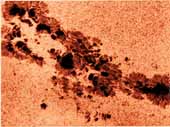 Educator's Guide to Sunspots
Educator's Guide to Sunspots
Courtesy of the Jet Propulsion Laboratory
Spotting Sunspots
Naked eye observations of the Sun will result in blindness. The
improper use of telescopes or binoculars will cause blindness
much faster. Now, having said that, there are safe and easy ways
to safely observe the Sun. Do not hesitate to use them.
The Sun and some of its behaviors are well know to youngsters.
They know the difference between night and day and the realize
that the Sun is up longer during the summer than in the winter.
But few, if any, of your students have ever directly observed the
surface of the Sun. They have no reason to expect that the Sun
is spinning or that it has blemishes which evolve over time.
If these facts are covered in a textbook students are forced to
accept these statements on faith alone. That is not a
particularly compelling way to learn. It is possible for
students to discover important details about the Sun themselves.
Incorrect observation of the Sun causes blindness because of the
tremendous amount of visible and invisible light coming off of
its surface. Sunglasses and other inappropriate filters may
block visible light but can not cut out enough ultraviolet and
infrared light, causing the eye's retina to burn out.
Looking through thick clouds or with UV-blocking sunglasses is
just as dangerous. Fortunately,
two things prevent major
problems. The first is that it is painful to look at the Sun.
Eyes tear up and you have to look away. The second is that few
youngsters bring sunglasses to class.
A projected image of the Sun is, however, perfectly safe to
observe. Binoculars, with the front of one ocular covered, can
be used to project a sharp image of the Sun on to a white piece
of paper. The binoculars are attached on a tripod, with a mount
or securely with tape. Place a piece of cardboard, at least
20 by 25 centimeters (8 by 10 inches),
with one hole the same size as the front of
one ocular at the front of the binoculars. Fasten it securely
with tape. It will cast a shadow on the paper.
Aim the binoculars by tilting them up and down and back and forth
until the Sun shines through. Never look through the binoculars
when they are pointing anywhere near the Sun! Sharpen the image
of the Sun on the paper by using the binocular's focusing knob or
lever. The size of the image can be altered by moving the paper
closer or farther from the binoculars.
Sunspots are appropriately named. They appear as spots on the
disk of the Sun. A sunspot will have a very dark central region
known as the umbra. It is often surrounded by a less dark halo
known as the penumbra. Think about the root and prefix of this
word for a good language lesson. The umbra is dark because it is
cooler (around 3,500°C/6,300°F) than the
surrounding sunscape (around 5,500°C/10,000°F).
Spots change over a period of several days. Penciling in the
detailed appearance and location of sun-spots on a fresh piece of
paper over several days can give a clear illustration of this.
They also move across the Sun as the Sun spins on its axis.
Because the Sun is fluid it does not spin as a rigid body. A
spot near the equator will take about 25 days to complete one
rotation. A spot near a pole, if there were ever one there, will
take over a month to make the trip. Collections of sketches over
a period of several years will also reveal the 11 year cycle of
sunspots. Over that period the numbers of spots goes from a
maximum to a minimum and back.
As with any experiment, follow good scientific procedures. Keep
appropriate records by being sure that all papers have the date,
time and appropriate viewing conditions written in the margins or
on the back of the drawings. Read more about sunspots and their
interesting behavior.
| 














